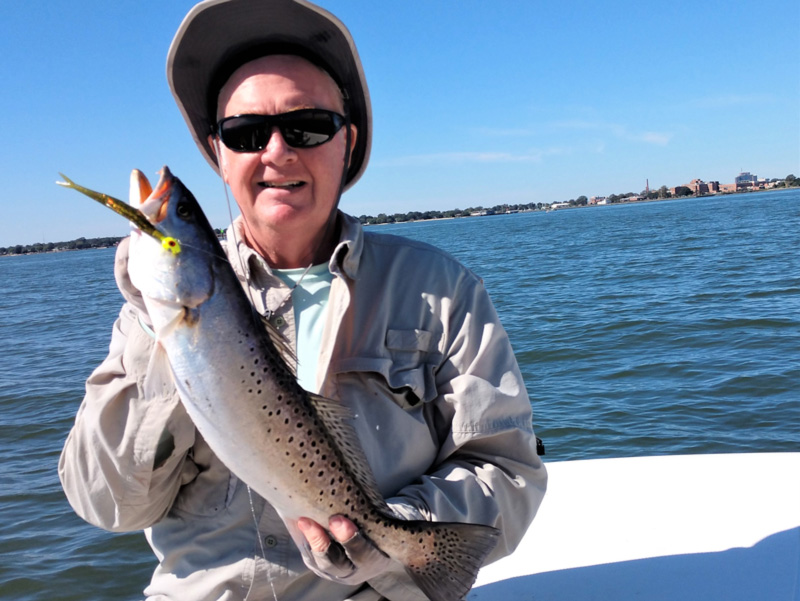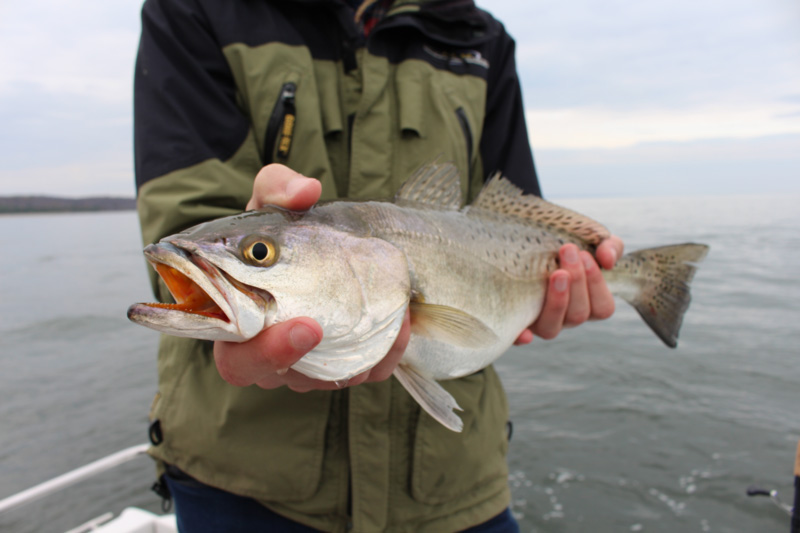Spring signals the beginning of speckled sea trout fishing season for me. This is when I uncover my boat and get it ready for that first trip of the year. I know there is fishing to be done in winter, but I have grown a bit lazy in recent years and usually wait until the warming days of spring. Typically, my first trip is a “shakedown cruise” to make sure everything is working, along with some time spent casting for that first speckled trout of the season.

During milder winters, specks never leave our area around Hampton and Virginia Beach, they just slow down. As the air warms, so does the water, and the fish become more active. I usually begin by checking out the same locations where I left them in the fall. This year will be different. With much construction going on at the Hampton Roads Bridge-Tunnel, some of my favorite locations are gone for good, and others have been temporarily changed. But there are still plenty of fishing holes that haven’t been touched by this massive project, and my hope is that the fish will simply move to these quieter locations.
Like most species, speckled trout look for warmer water as winter gives way to spring. This means starting to look for them in shallow areas where the sun warms the water faster. They are also moving a bit slower than later in the season. I keep this in mind and adjust my retrieve accordingly.
The vast majority of my time “speckulating” in any season is done with a leadhead jig tipped with a plastic tail. The jig has to be heavy enough to bounce along the bottom, but not too heavy. In water under five feet deep I may get by with a quarter-ounce jig. In water up to 10 feet I use either a three-eighths or half-ounce jig. Any deeper than that I only use half-ounce jigs. Jig style and shape are a matter of personal preference.
As for plastic tails I use a lot of Gulp! Swimming Mullets, and Gulp! Shrimp, along with an assortment of Z-Man products. There are three basic types of plastic tails people use for specks: swimming tails like the Gulp Mullet I just mentioned, jerk baits, and paddle tails. Each of these represent different types of baitfish. The trick is to zero in on what the fish are feeding on, which will have more to do with the shape of the lure I choose than the color. In general, I prefer lighter colored jigs and tails when I am searching for specks.
The basic retrieve for specks is to cast to or beyond the area you suspect is holding the fish. Allow the jig to hit bottom, then retrieve with two or three short jerks. Allow the lure to fall back to the bottom and repeat. Change the pace of your retrieve until you find what works. Specks almost always feed close to the bottom, and usually hit when the lure is falling.
Speckled trout are opportunistic feeders that can be stubborn at times. When I say “stubborn” I mean that at times they just won’t eat. At other times it seems they will hit almost anything. The smaller fish are more aggressive than larger ones. The small ones will hang out in big schools and seem to compete to get caught. The larger ones tend to be loners. However, if I catch a gator trout, I will work hard in that general area looking for more. At times, the bigger ones will travel in small packs of similar size fish.

I have made a commitment to myself this year to use more swimming plugs, especially in shallow water. These plugs come in three types: floating, suspending, and sinking. Floating plugs work very well in three feet of water or less. Unfortunately, there are few places that hold fish in my area that are that shallow. Suspending plugs will live up to their name and suspend below the surface when not being retrieved. When retrieved, these lures tend to swim just below the surface. And, you may have guessed that sinking plugs will drop to the bottom if allowed.
Looking for Speckled Trout
So, what do I look for? First, specks prefer moving water. I don’t see much difference between incoming or outgoing currents in general. However, there are spots where one tide is better than the other based on the location. I also like to fish near structure. Structure can be anything from underwater rocks or pilings to above water features such as jetties, docks, and bridges. The fish like to find a place they can sit just out of the moving water and ambush bait moving by in the current.
The presence of bait is also a plus when looking for specks. There is a lot less bait around in the spring than in the summer and fall, but it can still indicate the presence of feeding fish. In my area, finger mullet and small bunker (menhaden) are good to find. Further south, shrimp are a prime food species for trout. The bottom line is that these fish have to eat to survive, so they will be looking for an easy meal.
The fish will sometimes hold on a large flat of shallow water with sea grass. This is the time to pull out lighter jigs and topwater plugs, but since most speck anglers are just as stubborn as their prey, you may have to locate these shallow areas on your own. This crowd does not like to give away their favorite spots. Charts and aerial maps such as those from Google and Bing can help with this search.
Any combination of moving water, structure, bait, and the preferred depth can hold fish. Just remember, no one location will hold fish all of the time. Just because you caught them in a certain spot last week doesn’t mean they will be there this week. It is always better to have a few locations in mind when you leave the dock.
Spring Speck Hotspots
Since several of my favorite places to catch specks have been taken over by the Hampton Roads Bridge-Tunnel project, I plan to spread out a bit more this spring. I like the area between the Muggler Bridge and the MLK Bridge on Mercury Avenue in Hampton, not far from the bridge-tunnel. This area includes a large flat (on the Fort Monroe side) where wade anglers work the channel edge for specks. Areas near either bridge or along the channel edges may hold fish.
The area known as Poquoson Flats is also a promising location in our area. This large, shallow flat off of Plumtree Island is accessible by boat or kayak from the Poquoson area and doesn’t receive too much fishing pressure. Of course, Little Creek, Lynnhaven, and Rudy Inlets are all well-known areas for targeting speckled trout. Lynnhaven and Rudy Inlets are also served by very good boat ramps.
Remember, any area with relatively shallow water and some structure may hold trout. So, don’t be afraid to give that new spot a try.
-By Chuck Harrison